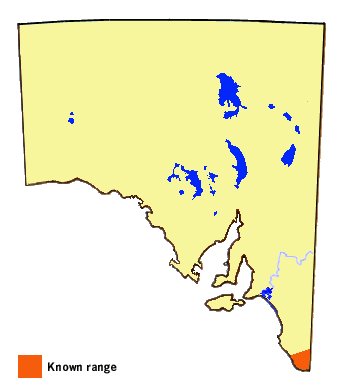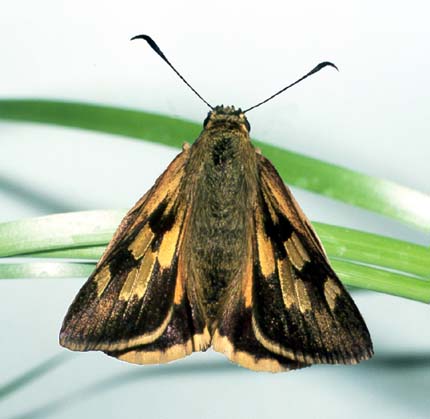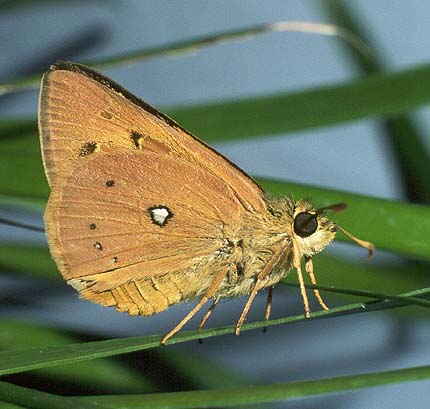- Larval Food Host
-
Lomandra longifolia (spiny-headed mat-rush), L. filiformis, L. multiflora multiflora (multiflowered mat-rush) (Asparagaceae). The skipper is only known to use Lomandra longifolia in South Australia. The other two potential foodplants, known to be used in the eastern states, have not been utilised in South Australia even though they can occur adjacent to L. longifolia. The larvae eat the leaves of the foodplant.
- Eggs
-
Large, initially cream, later marked red if fertile, hemi-spherical (domal) with strong vertical ribs numbering 19-20, laid singly on the foodplant. Eggs are usually laid on foodplant situated in full sun.
- Larvae
-
Mature final instar about 28-36 mm long.
- Pupae
-
Brown with darker markings, about 20 mm long, short and fat, with minimal ornamentation about the head, abdomen bristly, and the cremaster is very long, curved and spinose. Pupation takes place at the beginning of summer, either in the final larval shelter or the larva may leave the foodplant and pupate in leaf or bark debris around the base of the foodplant.
- Flight Period in South Australia
-
Late October to late January. Only one brood a year.

- Distribution
-
In South Australia it is confined to the Lower Southeast, and is found only where its foodplant occurs. It occurs in similar habitat to Trapezites symmomus, but flies earlier. It is very local in its distribution and is presently only known from a few areas. The skipper is also found in the higher rainfall areas along the coast and Great Dividing Range in Victoria and extending to as far north as northern Queensland.

- Habitat
-
Usually occurs in very open forest containing its foodplant, which requires moist conditions. It prefers its foodplant to be in full sun and uncongested by other plants. The males will hilltop although the presence of hilly areas is not a habitat pre-requisite.
- Conservation Status in South Australia
-
Vulnerable. Common in the eastern states.
- Threats
-
The skipper is confined to the remaining habitats of its foodplant, which is subject to the continuous threats of urban, agricultural and forestry requirements. Remaining areas of foodplant are now severely fragmented.
- Conservation Strategy
-
Its foodplant should be reintroduced to all conserved areas in which it originally occurred. Additional areas may need to be conserved and repopulated with foodplant, as suitable native open forest habitat, uncongested by other understorey plants, particularly bracken, is now rare. The foodplant is a good candidate for growing in urban gardens in the Lower Southeast, as it is tough, easily grown and looks good. Use of the plant in the urban and roadside environment in the eastern states has shown a massive increase in the allied T. symmomus butterfly population. (The local foodplant should be used, as the plant presently sold in nurseries originates from Melbourne and has a much broader leaf, and is silvery rather than glossy green.)

